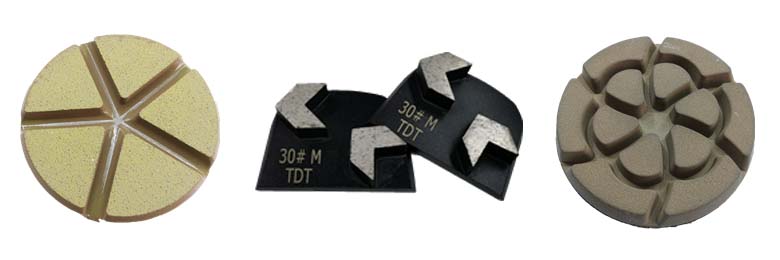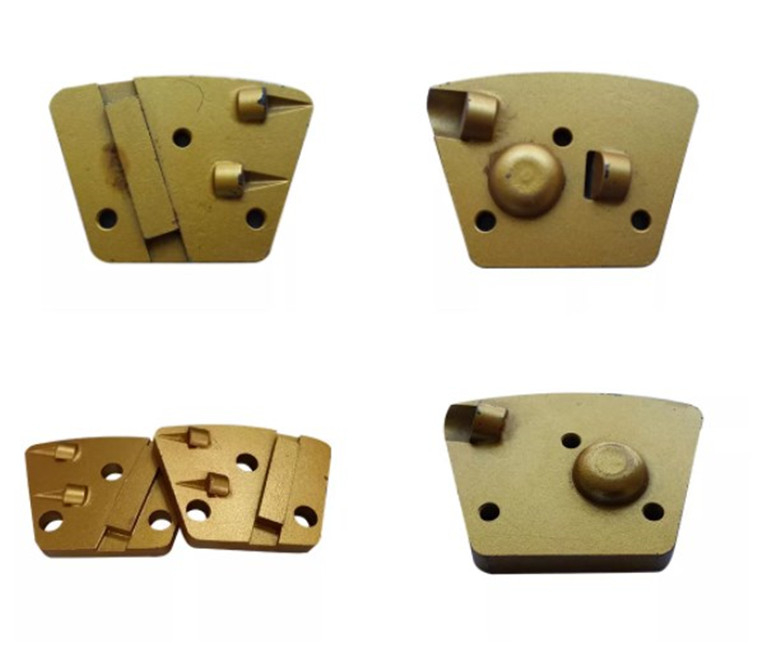How To Choose Grinding Discs For Concrete Floor?2022-04-08
Classification Of Concrete Grinding Discs:
Commonly used concrete grinding discs mainly include the following:
Polycrystalline diamond (PCD) disc: used to remove epoxy coating, which is needed when the coating is thick;
Concrete diamond grinding disc: used for concrete floor leveling and old floor renovation;
Concrete thick abrasive disc: usually refers to diamond resin abrasive disc with a thickness of more than 5mm, used for concrete floor leveling, rough grinding, fine grinding and polishing;
Concrete thin grinding disc: usually refers to a diamond resin soft grinding disc with a thickness of less than 5mm, which is used for rough grinding, fine grinding and polishing of concrete floors;
Concrete polishing pads: usually made of rayon, wool or other animal hair bonding and mixing, some products also add some abrasives and polishing accessories for polishing of concrete floors;
How To
Choose And Use Grinding Discs?
To understand how to properly select and use grinding discs, we must first
understand the following terms:
1- Flatness of the ground
Manually troweling and leveling the ground or the loose and severely damaged old ground, it is necessary to level or remove the loose surface layer, and a high-power grinder needs to be used.
The cement self-leveling floor or the floor
leveled by the trowel mechanical leveling machine has better flatness. Just use
the diamond resin grinding discs can make a beautiful polished floor, and the
grinding discs are also more economical.
2- Hardness of the ground
The concrete used in the design and construction of the concrete floor is represented by the label, which is what we usually call C20, C25, C30, etc. Under normal circumstances, the higher the label, the better the strength and hardness of the concrete, but due to various influence factors, the label of concrete and the hardness of the ground often do not correspond.
The hardness of concrete floors is usually expressed by Mohs hardness. The hardness of the concrete floor is usually between 3-5. On the construction site, we can use some substitutes to replace the Mohs hardness tester to understand the hardness of the ground: if the nails and keys can be used to draw depressions, damages and scratches,the hardness is less than 5, otherwise the hardness is greater than 5.
3- The weight and speed of the grinder
Floor grinders are usually divided into small, medium and large. Generally speaking, the larger the machine is, the higher the power is and the higher the efficiency is. In actual use, the bigger the machine is not the better. Although the grinding efficiency is high, the grinding machine that is too large and heavy will often lead to excessive grinding and increase the construction cost. Experienced workers will adjust the machine speed, moving speed, number of grinding discs and machine counterweight according to the characteristics of the machine to reduce construction costs and improve construction efficiency.
4-Type and grit of grinding discs
The most commonly used abrasives for floor treatment are PCD abrasive discs, metal-based abrasive discs and resin-based abrasive discs. PCD abrasive discs are used to remove thick coatings on the surface of floors, and metal-based abrasive discs are used for floor surface pretreatment and rough grinding, resin-based abrasive discs are used for surface rough grinding, fine grinding and polishing. The grit refers to the size of the diamond particles contained in the abrasive tool. The lower the number is, the larger the particle is.
PCD grinding discs are not divided into grit numbers, but they are directional, which should be paid special attention when using; metal grinding discs are usually divided into 30#, 50#, 100#, 200# and other numbers. Which grit numbers to use should be determined according to the ground conditions. For example, the flatness of the ground is not good or the surface is relatively loose, it may be necessary to use a 30# metal grinding disc to remove the loose surface layer and level the ground. The ground that needs to be frosted usually required 50# or 100# metal grinding discs to use; resin grinding discs are widely used, with grit numbers ranging from 30# to 3000#, and different grit numbers are distinguished by different colors. They are used for ground rough grinding, fine grinding and polishing. Resin abrasive discs are divided into hard abrasive discs and soft abrasive discs. Hard abrasive discs have better leveling effect and are more suitable for medium and large floor grinders. Soft abrasive discs have better polishing effects and are suitable for various types of floor grinders.
Knowing these concepts, let's get to the point.
What kind of ground should be dealt with?
Whether it is hard concrete or soft concrete, you can basically understand it by scratching the ground with an iron nail or a key. Those that cannot be scratched are classified as hard concrete.
For hard concrete floors, it is recommended to use soft-base metal grinding discs, use sharp resin grinding discs, increase machine counterweight, reduce mill speed, and reduce forward speed.
For soft concrete floors, it is recommended to use hard-based metal grinding discs, use durable resin grinding discs, increase the speed of the mill, and speed up the forward speed.
The quality of Chinese floors is mostly unsatisfactory, especially the renovation of old floors. The flatness is not good, the floor is loose, and the hardness is very poor. The water grinding process produces a lot of mud, and the abrasive consumption is particularly severe. For such floors, it is recommended to use medium and large grinding machine, after spraying water, use shade-dry grinding. First, use 30# hard base metal grinding disc to grind to remove loose surface layer and leveling treatment, and then use 100# medium hard base or soft base metal grinding disc to grind and process to improve the flatness and foundation. The hardness has been dealt with, and the back is much simpler.
Many renovations of old concrete floors can do this.
Is removing the coating necessary? What is the coating? How thick is the coating?
Refurbishment of epoxy floors requires the selection of abrasive tools according to the thickness of the coating.
For example: choose PCD grinding disc with mouthguard and single cutter head for thick coating; choose PCD grinding disc with mouthguard and double cutter head for medium-thick coating; choose 30# metal grinding disc for thin coating.
The method to use PCD cutter head is exquisite:
PCD discs are blade-type tools designed to remove coatings from the side, not from the top. Pay attention to the direction of the PCD cutter head when installing, keep half of the machine on the coating and the other half on the concrete when grinding, this method can keep the PCD grinding blade sharp. Don't spend too much time in the same place when removing the coating, just remove 70-80% of the coating and clean it up, and use a 30# metal abrasive disc to remove the rest.
Thin coatings applied by spraying, brushing or rolling can be removed with a 30# diamond disc, and a sharper 20# diamond disc is available. 3-inch diamond grinding disc is sharp and durable, specially used for epoxy floor renovation.
Which grinding method to choose? Water grinding or dry grinding?
1. Select the grinding disc according to the grinding method, use the dry grinding disc for dry grinding, and use the water grinding disc for water grinding.
2. Both thick grinding discs and thin grinding discs can be used for rough ground grinding, and there is no essential difference in use, but thick grinding discs can make the ground flatter and easier to achieve a uniform polishing effect; the grinding disc can also avoid frequent changing of grinding discs during grinding and improve construction efficiency.
3. Dry grinding saves more consumables than water grinding, but the weight, rotation speed and moving speed of the grinding machine should be considered when dry grinding, so as to avoid poor heat dissipation and burn the floor surface.
4. Water grinding construction is conducive to heat dissipation and lubrication and scouring, the grinding effect is more uniform and fine, and at the same time, it can avoid dust on the construction site.
Which grit to choose?
Usually we choose grinding discs according to different construction processes:
【Leveling treatment】 Choose metal grinding disc or 30#-50# resin thick grinding disc;
【Coarse grinding treatment】 Choose 50#-150# resin thick grinding disc or thin grinding disc;
【Fine grinding and fine grinding treatment】 Choose 150#-500# resin thick grinding disc or thin grinding disc;
【Polishing treatment】 Choose 1500#-3000# resin thin abrasive discs and 3000# or 6000# sponge polishing discs.

Summary:
The selection and use of grinding discs can be followed regularly: diamond grinding discs or concrete thick grinding discs are used for ground leveling and rough grinding; the rotating speed can improve the efficiency; try not to skip the number of grinding discs; dry grinding saves consumables than water grinding, but the water grinding treatment will make the ground more uniform and delicate; after washing the ground and drying it, use a thin grinding disc for high-speed dry polishing for better results ; the use of sponge polishing pads can improve the brightness of the ground.
DTS Diamond Tools offer a full line of high quality diamond tools for preparing, resurfacing and polishing a wide range of surfaces, including concrete, terrazzo, marble and stone. We dedicate our time, energy and resources in research and development of low cost and high-end floor preparation diamond tools that simplify the operation process. As a competent diamond tool manufacturer, we can manufacture special diamond tools for you in a wide variety of geometries, grain sizes and bonding, in a variety of diameters, lengths, and quantities. We have been producing innovative and customer-oriented solutions. Here, you will find the ideal solutions for your concrete-working, stone-working and other applications according to your specific needs.
- Company Info
- Feedback
- Customer Reviews
- About Us
- Contact Us
- Blog
- Help Center
- User Center
- Forget Password
- My Orders
- Tracking Order
- My Account
- Register




